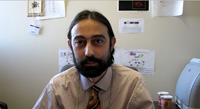10 mai 2012: Prof. Adolfo García Sastre
Thursday, May 10th 2012, 12h30
Prof. Adolfo Gacía Sastre
Department of Microbiology
Department of Medicine, Division of Infectious Diseases
Director, Global Health and Emerging Pathogens Institute
Mount Sinai School of Medicine, New York

"Induction and Evasion of Type I Interferon Responses by RNA Viruses"
Mammalian cells have evolved complex sophisticated and highly regulated pathways to recognize infection by RNA viruses resulting in interferon-mediated antiviral responses. In turn, RNA viruses have evolved intriguing mechanisms to evade or antagonize these innate antiviral pathways resulting in viral replication, transmission and, in many cases, disease. I will discuss some specific examples of these principles that we are studying in my laboratory.
Biography
Dr. García-Sastre is Professor in the Department of Microbiology and Co-Director of the Emerging Pathogens Institute at Mount Sinai School of Medicine in New York. He is also Principal Investigator for the Center for Research on Influenza Pathogenesis (CRIP), one of six NIAID Centers of Excellence for Influenza Research and Surveillance (CEIRS). Together with Charlie Rice, he is the leader of the basic research component on Viral Therapeutics and Pathogenesis of the North East Biodefense Center proposal, which was funded by NIAID and involves the collaboration of more than 20 academic institutions in New York, Connecticut and New Jersey. For the past 15 years, his research interest has been focused on the molecular biology of influenza viruses and several other negative strand RNA viruses. During his postdoctoral training in the early 1990s, he developed for the first time, novel strategies for expression of foreign antigens by a negative strand RNA virus, influenza virus. He has made major contributions to the influenza virus field, including 1) the development of reverse genetics techniques allowing the generation of recombinant influenza viruses from plasmid DNA (studies in collaboration with Dr. Palese); 2) the generation and evaluation of influenza virus vectors as potential vaccine candidates against different infectious diseases, including malaria and AIDS; 3) the identification of the biological role of the non structural protein NS1 of influenza virus during infection: the inhibition of the type I interferon (IFN) system; and 4) the reconstruction and characterization of the extinct pandemic influenza virus of 1918. His studies provided the first description and molecular analysis of a viral-encoded IFN antagonist among negative strand RNA viruses. These studies led to the generation of attenuated influenza viruses containing defined mutations in their IFN antagonist protein that might prove to be optimal live vaccines against influenza. His research has resulted in more than 100 scientific publications and reviews. He was among the first members of the Vaccine Study Section of the NIH. In addition, he is an editor for Journal of Experimental Medicine and PLoS Pathogens and a member of the Editorial Board of Journal of Virology, Virology, Journal of General Virology and Virus Research. He has been a co-organizer of the international course on Viral Vectors (2001), held in Heidelberg, Germany, sponsored by Federation of European Biochemical Societies (FEBS), and of the first Research Conference on Orthomyxoviruses in 2001, held in Teixel, The Netherlands, sponsored by the European Scientific Working Group on Influenza (ESWI).
